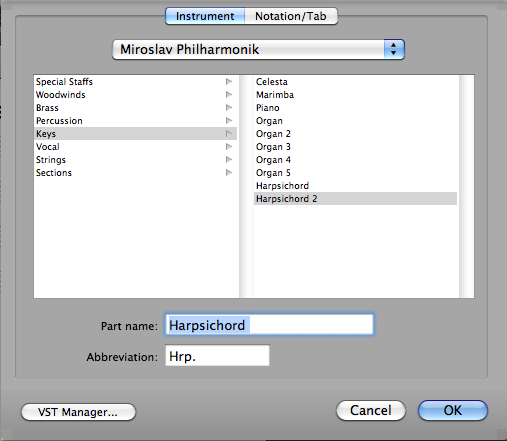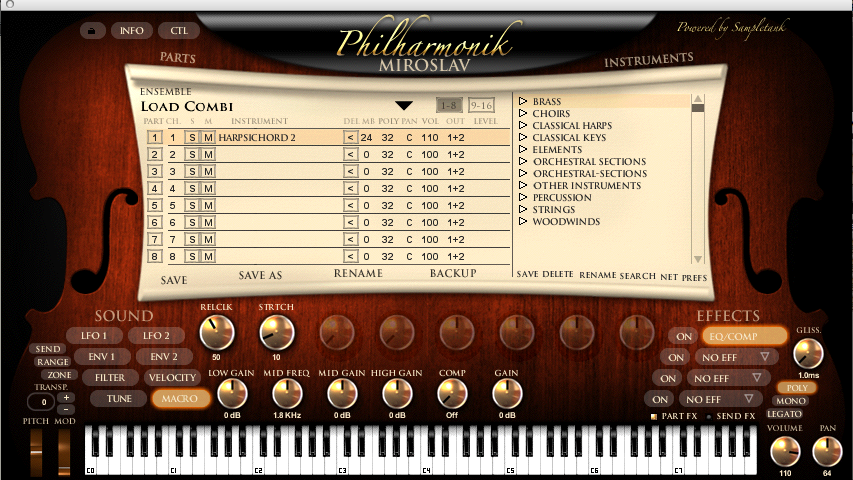Francois2010 wrote:I do not hear music with N3 Reverb Off. It's really too dull for me.
If you only listen to instruments when there is a lot of reverberation, then what you hear always will be different, because reverberation changes the way instruments sound . . .
This is
not necessarily bad, but if you never listen to instruments without reverberation then you never learn how the instruments actually sound, which in turn makes it more difficult to determine useful reverberation settings . . .
I like reverberation, echo, digital delay, phasing, flanging, doubling, and so forth and so on, but it is important to know how everything sounds without it . . .
Nevertheless, the fact of the matter is that reverberation, echo, digital delay, flanging, doubling, and so forth and so on dramatically change the way instruments and voices sound, often in dramatic ways, and in some respects the most dramatic changes are made by reverberation, which as a general rule transforms an instrument or voice in significant ways that affect overall tonal qualities to the point that for all practical purposes running an instrument or voice through reverberation is like running it through an electric guitar effects pedal, which in some respects can give it a cartoon-like quality that makes it a highly-tailored caricature of itself . . .
Explained another way, the combination of (a) being extraordinarily precise with respect to the way specific notes sound but (b) running everything through level-50 dry vs. wet reverberation in a level-50 sized room with level-25 predelay is a bit of a virtual oxymoron, because this level of reverberation and room size with predelay tends to introduce so much sonic blur that expecting anything to sound precise is a bit absurd, really . . .
http://en.wikipedia.org/wiki/ReverberationReally!Reverberation can be very melodic, as well as rhythmic, which is one of the reasons it is used as an effect for singing in popular music, with "Fame And Fortune" (Elvis Presley) being a stellar example, where in particular Elvis was superbly skilled in what I call "working" a condenser microphones, vacuum-tube compressor-limiters, and vacuum-tube plate and chamber reverberation systems, all of which he controlled primarily by varying (a) the volume level of his singing, (b) the voicing of his singing, and (c) the distance from the condenser microphone, all with mind-boggling precision and finesse, for sure . . .
[
NOTE: All these devices initially are setup and configured by audio engineers, but once they are in place, intuitive singers discover how to "work" them, which is easy to observe when you understand the various infrastructure, since among other things this hypothesis is quite consistent with the observed behaviors of singers who perform primarily in amplified scenarios, which for the most part span every scenario except (a) actually being in the same room physically with the singer when there are no amplifiers and loudspeakers or (b) when being in the audience in a concert hall where nothing is amplified by a sound reinforcement system, which for most popular music maps only to a handful of people ever actually hearing how a singer really sounds, since even when the singer is "at home" and sings at the piano or whatever in a television broadcast, nevertheless there is a microphone and elaborate broadcast audio equipment being used with the result that once again everything you hear is electromagnetic in one way or another . . . ]
http://www.youtube.com/watch?v=-oujzwBd9TYFor sure! In what I call the "digital delay" universe, it is difficult to beat John Lennon (albeit with a bit of help from George Martin and Phil Spector), where specifically this type of what generally is classified under the larger umbrella of reverberation is constrained primarily to the range of typically single-repeat echoes from 25 milliseconds to 100 milliseconds, with it occasionally extending to 250 milliseconds, since anything greater tends to be a large and distinct echo in one way or another . . .
http://app.psychonomic-journals.org/content/70/8/1558.abstracthttp://en.wikipedia.org/wiki/Haas_effecthttp://en.wikipedia.org/wiki/Precedence_effect[
NOTE: John Lennon had extraordinarily precise intuitive rhythmic timing, and he had a lot of FUN with rapid echoes in the range of 25 milliseconds to 100 milliseconds, both in his rhythm guitar playing and in his singing. At first, I think he did it intuitively, perhaps as an ego-motivated effort to be heard, but as he gained more experience in recording studios he did it consciously by design. This is part of what made him such a stellar lead singer, since the overall effect was that his singing literally was easier for listeners to perceive, which was due in no small part to a virtual festival of exquisite auditory illusions . . . ]
"Instant Karma" (Plastic Ono Band) is an excellent example, which is fabulous . . .
http://www.youtube.com/watch?v=EqP3wT5lpa4Fabulous! John Lennon also was very skilled in "working" a condenser microphone, as one can observe in this Ed Sullivan Show appearance of the the Beatles in 1964, which was very early in their careers, and he already had a very precise mapping of his vocal range, different voicings, and so forth with respect to the correct distance from the condenser microphone, which is quite fascinating to observe, really . . .
http://www.youtube.com/watch?v=D8j_7VJ0RMwReally!Explained yet another way, this is the primary reason that recording studios tend to be very dry rooms, sometimes to the point of being nearly anechoic, or at least semi-anechoic, because it is considerably easier for producers to use reverberation, echo, and so forth as special effects when the recorded tracks are as dry or devoid of reverberation, echo, and so forth as possible, where for example the
RAE Multimedia™ sound isolation studio is semi-anechoic, in part due to having a fully floated floor done in a relatively inexpensive but effective way, where after doing a bit of research I found a supply of interlocking rubber mats made from ground truck tires, which were intended for use as floor covering for a wood-working shop or whatever but were on sale due to general lack of interest among people who had wood-working shops, and I augmented the rubber mats with layers of tar paper and fiberglass insulation. Floating a floor on rubber mats is not so effective as floating a floor on an elaborate system of springs and hydraulic dampers, but it costs a lot less and works reasonably well, with one of the keys being to avoid actually attaching the floated floor to the rubber mats or the underlying floor(s), since even a single nail or woodscrew becomes a troublesome pathway for acoustic energy, although more in the upper-mid and higher frequencies . . .
http://en.wikipedia.org/wiki/Anechoic_chamberThere are quite a few ways to enhance instruments and voices with reverberation, echo, phasing, flanging, doubling, and so forth and so on, but it is very difficult--if not impossible--to remove these things when they are present in the original recorded tracks, so the best way to have the most precise control over these types of effects is to add them after the fact using effects processors and other types of digital, electronic, and physical equipment . . .
And since some of the auditory illusions created by reverberation, echo, phasing, flanging, doubling, and so forth and so on involve working with very small ranges of time, it tends to be a "by ear" activity, where one can use various rules of acoustic physics and auditory perception as guidelines for setting the initial parameters of these types of effects but fine-tuning is done "by ear", although with constant attention to the various rules, where for example the rules for the Haas Effect provide a few clues with respect to the practical upper and lower boundaries for echo arrival rates and echo volume levels, which has a restricting influence in the sense that if the boundaries thresholds either (a) are not met or (b) are exceeded, then the specific auditory illusion does
not occur . . .
Francois2010 wrote:Do you believe that N3 could make corrections to this instrument for the next update?
If there were a mistake in the playing and recording of this particular instrument, then one might suppose that anything is possible . . .
I do
not think that it makes any sense to do a new recording of the particular instrument, but if it only involves redoing the digitizing step(s) for a specific note
and if the specific note is determined to be erroneous, then I suppose that it could be something that makes sense, depending on what is involved in redoing the digitization . . .
Nevertheless, I think that there are more important things to do than to fine-tune the nuances of specific instrument notes . . .
The simpler and more practical solution is to expand your VSTi instrument libraries so that you have more flavors of instruments . . .
For example, this is the sample score you provided but with Miroslav Philharmonik instruments and the same Notion 3 Reverb setting . . .
http://www.surfwhammys.com/FD-Octave-Miroslav-Philharmonik-Reverb.mp3And this is the sample score you provided but with Miroslav Philharmonik instruments; without Notion 3 Reverb; but with full panning rather than the selected panning . . .
[
NOTE: Using the default "full panning" for Miroslav Philharmonik VSTi instruments is interesting, since the instruments were recorded in their typical locations within a full orchestra, so by using full panning you get the benefit of accurate placement within a full orchestra. However, there also are studio recordings of some of the instruments, which have a very different sound than the recordings made in the concert hall . . . ]
http://www.surfwhammys.com/FD-Octave-Miroslav-Philharmonik-No-Reverb-Full-Panning.mp3If you listen carefully to the second version, you will hear that the "dry" instruments actually have reverberation, which is due to the instruments being played and recorded
in a concert hall (specifically, the Rudolfinum Dvorák Concert Hall)
 Rudolfinum Dvorák Concert Hall
Rudolfinum Dvorák Concert HallIn contrast, the London Symphony Orchestra (LSO) samples for Notion 3 were recorded in Abbey Road Studios, which is where the Beatles were recorded, so the LSO samples will be very different, which is fine with me . . .
There are differences in the Notion 3 LSO samples and the Miroslav Philharmonik samples, and I use the specific instrument samples that are best suited to what I want to do . . .
These are real instruments played by real musicians, and there will be differences, no matter how it is done . . .
If you want everything to be completely and totally precise in every respect, then there are several ways to achieve this goal:
(1) hire musicians to play specific instruments in whatever setting you require . . .
(2) play the specific instruments yourself . . .
(3) construct the emulated sounds of the specific instruments with an advanced synthesizer . . .
Of these three options, the most practical is (3), since a good bit of the work already is done for many different types of instruments using a variety of advanced synthesizers . . .
For example, IK Multimedia has several advanced synthesizer VSTi libraries with standalone user interfaces that make it possible to fine-tune the various presets . . .
http://www.ikmultimedia.com/samplemoog/features/http://www.ikmultimedia.com/soniksynth/features/[
NOTE: There are Xpansion Tank 2 multi-sampled libraries for OmniSynth 2, SampleArp Solo, and SampleOB Xpander. You can listen to some of the samples by clicking on "Read more", where you will find the online audio player . . . ]
http://www.ikmultimedia.com/xpansiontank/multisamples/MOTU has an advanced synthesizer (MX4) that looks interesting, as well . . .
http://www.motu.com/products/software/mx4/And there are other VSTi synthesizers, really . . .
Really! 


